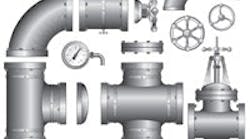A data sheet for a reactor flow-control valve called for a “shutoff head.” Given that this control valve handled ethylene oxide (EO), a highly volatile and reactive compound, the requirement gave me pause. Addressing it involved more than defining the pump deadhead pressure. Here’re some thoughts to consider.
[pullquote]
First, it’s important to understand that a control valve isn’t a shutoff valve. A control valve must provide precise adjustments to flow. Crunching down on the plug to block flow can cause damage. The actuator and linkage of a control valve aren’t designed for tight shutoff; a shutoff valve’s actuator is. If you want to prevent leakage, install a shutoff valve.
Unfortunately, no standards define control-valve shutoff head. A few describe leakage through the body of a valve; this leakage is categorized poorly as Class I-VI in ANSI/FCI 70-2, “Control Valve Seat Leakage.” Valves also leak from their stems. For stem leakage, refer to ISO-15848, “Industrial Valves — Measurement, Test and Qualification Procedures for Emissions – Part 1...” This specification is best because it recommends helium as the test medium. API-622, “Type Testing of Process Valve Packing for Fugitive Emissions,” also describes stem leakage but for methane.
However, we’re concerned about defining the shutoff head for a control valve specification, not leakage. For this, understanding the limits of valve body type is important. Obviously, butterfly valves won’t provide tight shutoff — although I have seen them used where leaking is acceptable, such as where thermal expansion is allowed. Be aware that thermal expansion could cause the valve seat to stretch or dislodge. In this case, the valve itself limits the shutoff head. Butterfly valves are available with shutoff heads of 175 psi and up, but, in practical terms, the limit is more like 50 psi or less. Diaphragm and other soft-seat valves have the same problem. Gate valves, with their exposed seats and metal-on-metal sealing surfaces, are a bad choice. Globe valves, while often most effective for control, are the worst option. Ball and plug valves probably offer the best choice for shutoff.
Lack of mechanical strength is a common problem with soft seats but less of an issue with hard, metal-on-metal seats. Soft seats are best for sealing against streams containing solids, such as slurries. Hard surfaces, polished smooth, work best at high temperatures, above 250°F, where polymers begin to break down or flow; solids quickly ruin polished surfaces. Fluoropolymers can extend the range of soft seats to 350°F. However, hard plastics retain memory and can be scratched just like metal; memory retention gets worse above 200°F. Partially-fluorinated polymers generally outperform polytetrafluoroethylene (PTFE) in fabricated liners but PTFE serves well as sheets. Ceramics offer a useful alternative to metal in erosive environments but not without sacrificing tight shutoff.
Enough about the peripherals, let’s get down to specifications. Several scenarios can define shutoff head: 1) flow provided by a mover, e.g., a pump or compressor; 2) pressure isolation; 3) temperature control; and 4) safety, i.e., prevention of a chemical reaction. In the first case, use the deadhead pressure of the mover. (Deadhead is the extreme left corner on a pump curve.) For a pump, pick the deadhead for the largest impeller possible. For temperature control, use the regulator steam pressure — unless a significant risk is present and the steam is stepped down, in which case use the original pressure. Safety is a tricky subject.
If a chemical such as EO is involved, safety trumps a pump curve. EO leaking past the isolation valves to the reactor could lead to a release or worse. In this situation, as in the others requiring a tradeoff between control and isolation, don’t rely on a control valve for shutoff: put automatic valves upstream and downstream of the control valve for isolation. Install pressure switches and pressure transmitters to monitor thermal expansion and use thermal relief valves to blow expanding liquids back to storage. Both switches and transmitters are valuable because transmitters are limited to <100-ms response time and switches don’t trend.
Lastly, let’s look at actuators. If a control valve is to function as a reliable shutoff valve, a positioner is an absolute necessity. Ideally, use one with a 0–100% position indicator. Specify an open-and-closed position indicator for all automatic valves used for shutoff. Take care in selecting the actuator air pressure and supply; evaluate the pressure reliability before selection; plan for 1 scfm of air per control valve or automatic valve that’s 6 in. or less in size.

DIRK WILLARD is a Chemical Processing contributing editor. He recently won recognition for his Field Notes column from the ASBPE. Chemical Processing is proud to have him on board. You can e-mail him at [email protected]



